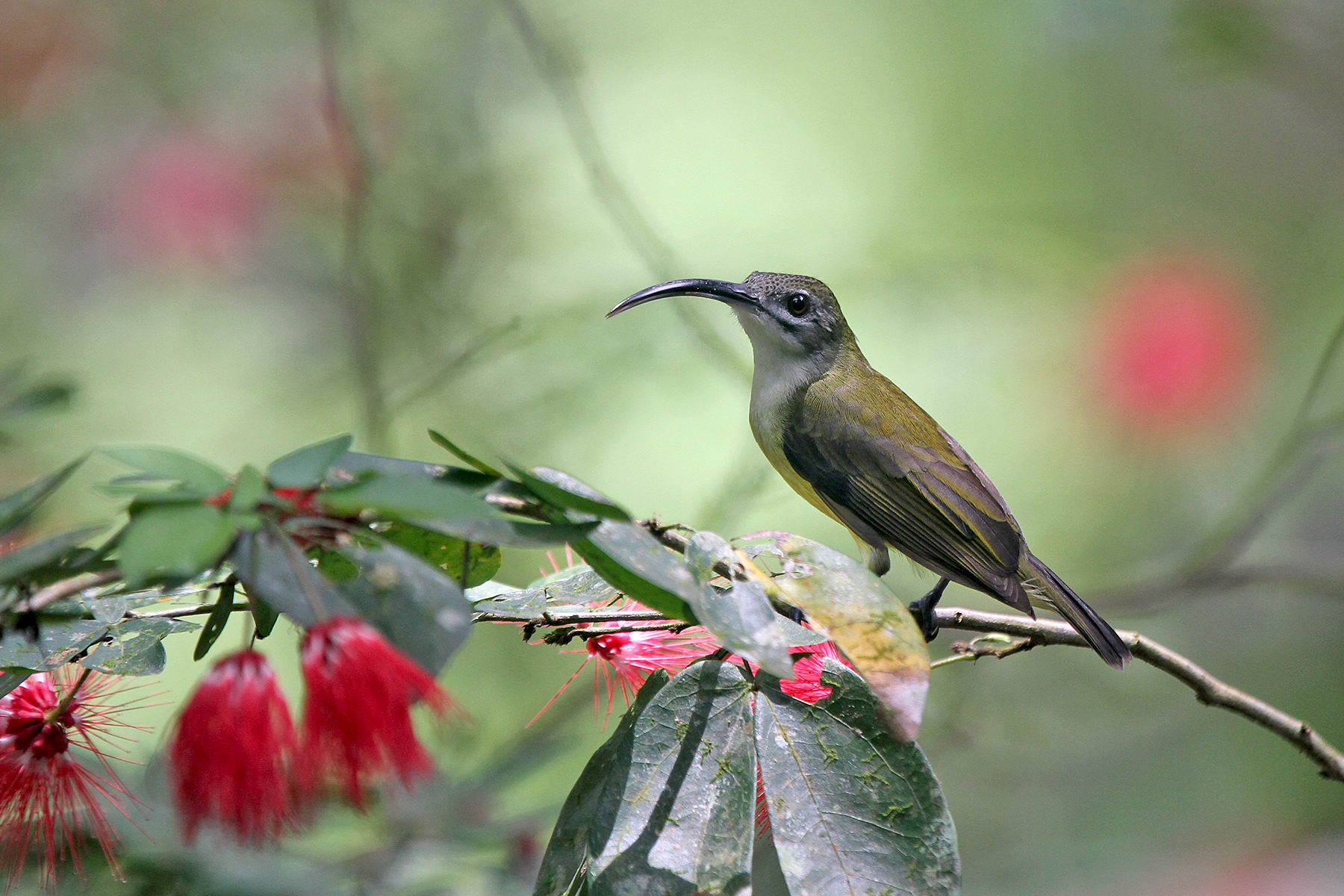BORNEO: SABAH PHEASANTS & SPECIALITIES OF SARAWAK BIRDING TOUR: DETAILED ITINERARY
Borneo: Sabah Pheasants & Sarawak: Day 1 Our tour starts around midday at Kota Kinabalu airport in Malaysia’s Sabah state in northern Borneo.
(It is generally easy to incorporate Kota Kinabalu into your international tickets if you are flying with Malaysian Airlines, but if you are arranging your international flights yourself and would find it easier if we arranged your regional flights for you, we will be pleased to assist.)
From Kota Kinabalu, we will transfer to the town of Ranau, situated to the east of Mount Kinabalu, for an overnight stay.
Borneo: Sabah Pheasants & Sarawak: Day 2 This morning we will set out early and visit an area in the Crocker Range where we have a good chance of seeing both Crimson-headed Partridge (or Bloodhead) and Red-breasted Partridge.
Afterwards, we will continue to the Trus Madi area for a two nights stay. In the late afternoon, we will have our first hide/blind session, hoping to see the wonderful but shy Crested Partridge come to a feeder.
Borneo: Sabah Pheasants & Sarawak: Day 3 Today should be something extraordinary as we visit one or two hides/blinds where the rarely observed endemic Bulwer’s Pheasant regularly comes to feed. Quite often multiple individuals are present! Needless to say, encountering this amazing bird is going to be one of those ‘memories of a lifetime’!
Another amazing visitor to the hides is the spectacular Great Argus pheasant with its enormous tail!
Other species that regularly occur at the hides/blinds include such Bornean endemics as the dazzling Bornean Banded Pitta and Dayak Blue Flycatcher, plus the perky Short-tailed Babbler.
While at Trus Madi we also have chances for Blue-banded Pitta, the monotypic Rail-babbler, Bornean Bulbul, Bornean Leafbird, Pygmy White-eye (or Pygmy Helaeia) and Bornean Spiderhunter.
After dark, we will be seeking the impressive Barred Eagle-Owl and Bornean Frogmouth.
Borneo: Sabah Pheasants & Sarawak: Day 4 After a final morning (perhaps at one of the hides) we will transfer to Beaufort for an overnight stay. We may arrive in time for an initial visit to Klias Wetland.
Borneo: Sabah Pheasants & Sarawak: Day 5 This morning we will reach the Klias Wetland Reserve near the Sarawak border by first light. The lowland peat-swamp forest here is a rare habitat nowadays in the Malaysian parts of Borneo and the protected fragment at Klias is home to several localized, habitat-specific species. We will be searching in particular for Hook-billed Bulbul, Red-crowned Barbet, Grey-breasted Babbler and Scarlet-breasted Flowerpecker.
Additional species we are likely to encounter today include the near-endemic Yellow-rumped Flowerpecker, Black-bellied Malkoha, Grey-rumped Treeswift, Long-tailed Parakeet, Common Hill Myna, Grey-and-buff Woodpecker, Diard’s Trogon, Oriental Dwarf Kingfisher, Glossy Swiftlet, Oriental Magpie-Robin, House Swift, Asian Palm Swift, Collared Kingfisher, Blue-throated Bee-eater, Pacific and Barn Swallows, Dark-necked Tailorbird, Ashy Tailorbird, Chestnut-rumped, Fluffy-backed and Chestnut-winged Babblers, Yellow-vented Bulbul, Pied Triller, Malaysian Pied Fantail, White-breasted Wood Swallow, Black Hornbill, Pink-necked Green Pigeon, Olive-winged Bulbul, Asian Glossy Starling, Olive-backed Sunbird, Eurasian Tree Sparrow Spotted and Zebra (or Peaceful) Doves, Greater Green Leafbird, Ruby-cheeked, Copper-throated, Olive-backed and Brown-throated Sunbirds, the near-endemic Dusky Munia and Chestnut Munia.
Afterwards, we will cross the border into Malaysia’s Sarawak province. At Lawas we will change to 4×4 vehicles for our journey to the remote settlement of Ba’kalalan, situated at 975m (3200ft) in the Kelabit Highlands, close to the border with Kalimantan, where we will stay for two nights.
Stops along the way could well produce Red-bearded Bee-eater, Yellow-crowned Barbet, Dark Hawk-Cuckoo and Brown-backed Needletail among others.
Borneo: Sabah Pheasants & Sarawak: Day 6 Large tracts of excellent submontane forest are a feature of the Ba’kalalan area and these are now accessible along recently constructed but little-used roads that span a wide altitudinal range.
The forests around and above Ba’kalalan are home to such specialities as Dulit and Bornean Frogmouths and Hose’s Broadbill and we will be concentrating on these Bornean endemics as they are either very difficult or impossible to see in other areas in Borneo that are visited by birders.
In addition, an excellent variety of other Bornean specialities occur in the area, including Bornean Banded and Blue-banded Pittas, Whitehead’s Broadbill, Whitehead’s Spiderhunter, Pygmy White-eye (or Pygmy Ibon), Bornean and Mountain Barbets, Bornean Leafbird, Bornean Bulbul, Chestnut-hooded Laughingthrush, Bornean Spiderhunter, Bornean Treepie, Chestnut-crested Yuhina, Golden-naped Barbet, Black-throated Wren-babbler and Mountain Serpent Eagle, several of which are easier to see in Sarawak than elsewhere.
In addition to the endemic frogmouths, other nightbirds present include Malaysian Eared Nightjar, Sunda Scops Owl, Bar-bellied Eagle-Owl and Brown Hawk-Owl, though a certain element of luck is required with some of these species.
Red-breasted, Crimson-headed and Ferruginous Partridges all occur but are hard to see in the impenetrable forest. There is even a slim chance of coming across the extremely rare Bulwer’s Pheasant in the hills around Ba’kalalan.
More widespread species that we are likely to encounter here include Crested Honey Buzzard, Mountain Imperial Pigeon, Thick-billed Green Pigeon, Blue-crowned Hanging Parrot, Black-bellied Malkoha, Giant Swiftlet, Orange-breasted Trogon, Banded Kingfisher (the Bornean form is sometimes split as Black-faced Kingfisher), Philippine and Little Cuckoo-Doves, Golden-whiskered and Blue-eared Barbets (the Bornean and Malay Peninsula forms of the latter are sometimes split as Black-eared Barbet), Banded, Olive-backed and Orange-backed Woodpeckers, Green, Banded and Black-and-yellow Broadbills, Black-thighed Falconet, Cinereous Bulbul (the form here, connectens, is sometimes split as Green-winged Bulbul), Black-headed Bulbuls, Lesser Green Leafbird, Large Woodshrike, Sunda Cuckooshrike, Scarlet Minivet, Rufous-tailed Jungle Flycatcher, Indigo and Hill Blue Flycatchers (plus Dark-sided and Asian Brown Flycatchers at times when these migrants are present), Grey-headed Canary-flycatcher, Golden-bellied Gerygone, Rufous-fronted and Temminck’s Babblers, Black-and-crimson Oriole, Velvet-fronted Nuthatch, Ashy and Hair-crested Drongos, Crested Jay, Slender-billed Crow, Temminck’s Sunbird, Plain Flowerpecker, Little Spiderhunter and Paddyfield Pipit.
Borneo: Sabah Pheasants & Sarawak: Day 7 After a final morning in the Ba’kalalan region we will return northwards until we reach Long Tuyo where we will spend the night.
Borneo: Sabah Pheasants & Sarawak: Day 8 After some early morning birding around Long Tuyo we will drive along a long-disused logging track to the vicinity of Paya Maga. From the end of the drivable track, we have a two-hour walk higher into the hills. We should arrive in time for lunch and we will have the rest of the afternoon to explore the Paya Maga area.
It is around our camp at approximately 1700m (5578ft) that we expect to find the recently rediscovered endemic Black Oriole, which is a regular visitor to the area.
Being at a generally lower elevation than Ba’kalalan and with higher rainfall, the forest at Paya Maga contains a subtly different avifauna, including a higher volume of fruit-eating species. There is much overlap in species, however, so we will have second chances for some of the trickier species, such as Blue-banded Pitta and Dulit and Bornean Frogmouths.
With a bit of good fortune, we will also encounter one or more of the scarcer or shyer species of the area such as Crested Partridge, Great Argus (usually only heard), White-crowned Hornbill, the rare endemic Hose’s Broadbill, White-necked Babbler or even the monotypic Rail-babbler.
Additional species we may expect to encounter at Paya Maga include Blyth’s Hawk-Eagle, Rufous-bellied Eagle, Crested Serpent Eagle, Common Emerald Dove, Raffles’s and Red-billed Malkohas, Banded Bay and Plaintive Cuckoos, Whiskered Treeswift, Rhinoceros, Wreathed and Helmeted Hornbills, Brown Barbet, Blue-crowned Hanging Parrot, Maroon-breasted Philentoma, Bar-winged and Black-winged Flycatcher-shrikes, Black-naped Monarch, Slender-billed Crow, Scaly-breasted, Cream-vented, Asian Red-eyed, Spectacled, Finsch’s, Yellow-bellied, Buff-vented and Streaked Bulbuls, Grey-headed and Black-capped Babblers, Bold-striped Tit-Babbler, Everett’s White-eye, White-rumped Shama, Yellow-eared Spiderhunter and Grey-breasted Spiderhunter.
Borneo: Sabah Pheasants & Sarawak: Day 9 After some final birding at Paya Maga we will descend to the road and transfer to Long Tuyo for an overnight stay.
Borneo: Sabah Pheasants & Sarawak: 10 The lower altitude forests around Long Tuyo hold a wide selection of widespread Bornean birds and there is also another chance of the elusive Rail-babbler in this area.
Later we will return to Beaufort for an overnight stay.
Borneo: Sabah Pheasants & Sarawak: Day 11 This morning we will return to Kota Kinabalu airport, arriving around midday.
BORNEAN PEACOCK-PHEASANT EXTENSION
Bornean Peacock-Pheasant: Day 1 The extension starts around midday at Kota Kinabalu airport. Transfer to Telupid via Ranau for a two nights stay.
Bornean Peacock-Pheasant: Day 2 The wonderful Bornean Peacock-Pheasant has taken to visiting a hide/blind in this part of Sabah, although not as reliably as the Bulwer’s Pheasants at Trus Madi. Even so, the chances over two days are very good.
Other birds turn up at the hide. The spectacular Bornean Crested Fireback is fairly regular and other visitors have, on rare occasions, included Giant Pitta!
Bornean Peacock-Pheasant: Day 3 We will return to the peacock-pheasant hide today and then transfer to Ranau to join up with those arriving for the main tour.
FRIENDLY BUSH WARBLER EXTENSION
Friendly Bush Warbler: Day 1 The extension starts around midday at Kota Kinabalu airport. Transfer to Mount Kinabalu for an overnight stay.
Friendly Bush Warbler: Day 2 Once upon a time the endemic and very range-restricted Friendly Bush Warbler, also known as Kinabalu Friendly Warbler or Kinabalu Grasshopper Warbler, was relatively simple to see. You just hiked along the first part of the trail up Mount Kinabalu beyond the roadhead. Sadly, not in recent times as the park closed off the trail to all but those heading for the summit of the mountain. The summit trail is now strictly regulated.
Luckily there is another locality where the species is relatively straightforward to see and access only requires a relatively short (1 hour) but steep walk. This morning we will be visiting the area and we have a very high chance of good views of this fairly shy warbler that does not really live up to its name!
After lunch we will meet up with those arriving for the Bornean Peacock-Pheasant extension and head for the town of Telupid.


































































